- A day by photo feature of the 8 days we
spent in Ranchi, Sammed Shikhar ji, Gaya, Rajgir, Nalanda and Patna.
We reached Mumbai airport for a Ranchi flight only to be told the flight had left early so we paid extra and bought a ticket for the next day.
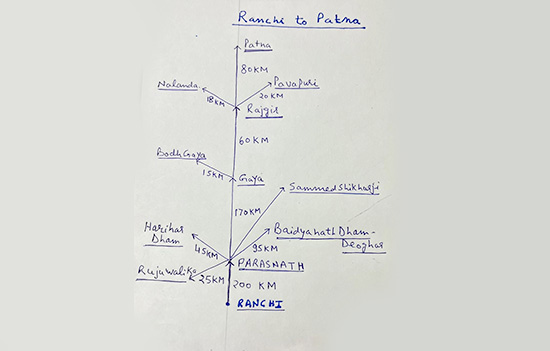 Our program, always write down like this.
Our program, always write down like this.
Ranchi
Thus we got to spend only half a day in Ranchi.
We climbed 500 steps to visit the Pahari
Mandir, a Shiv Mandir. The view of the entire city is visible from top of the
mountain.
We had reserved two beds at Ranchi
Railway Station retiring room dormitory facility. So after having dinner went
to sleep. We had to catch the 6 am train to Parasnath, the nearest railway
station to the most sacred Jain Tirth Sammed Shikhar Ji.
Day 2 PARASNATH
Got to know an old friend was taking a Jain Sangh to Sammed Shikhar Ji. He asked us to join. We reached Parasnath Railway Station at around 10.30 am where Jain Sangh’s buses were waiting. From the station we directly went to Rujuwalika Jain shrine i.e. located 25 kilometres away.
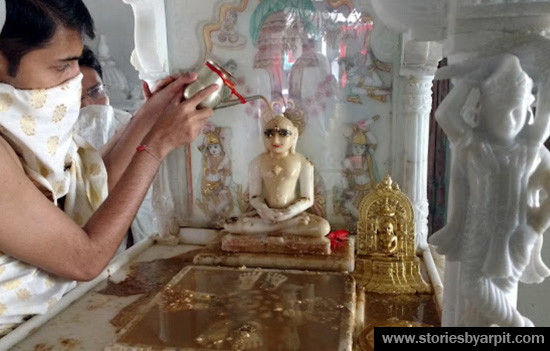 Conducting 18 Abhishek
on murti of Bhagwan Mahavir. Credit
Arpit Shah.
Conducting 18 Abhishek
on murti of Bhagwan Mahavir. Credit
Arpit Shah.
This pilgrimage is very sacred and
popular because Lord Mahavira did rigorous penance for twelve years under a Saal
tree in the field of a farmer named Shyamak on the bank of the river Rijubaluk
(Rujuwalika) and thereafter attained the Kaivalya
Gyan. Two
amazing Jain temples are constructed behind the main Temple.
 Remain of Sal tree. Credits Arpit Shah.
Remain of Sal tree. Credits Arpit Shah.
Our night stay was at
village Madhuban at the foot hills of Sammed Shikhar JI. The Dharmshala named Siddhaytan was of a
3-star hotel level.
Also read a good piece on visit to Rajuwalika shrine
Day 3 Baba Baidyanath
Dham, Deoghar
Early morning, we attended Puja at the
Jain temple in the premises of Siddhaytan Dharamshala and after breakfast, we
started for Baba Baidyanath Dham, Deoghar, which is one of the 12 Jyotirlingas
in India and is 95 kilometre from village Madhuban.
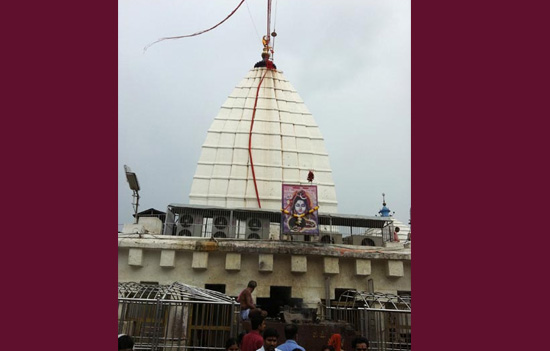
We reached Baba's Dham after crossing a labyrinth of very narrow lanes in Deoghar. Seeing the crowd and faith of people in the temple was a pleasant thrill.
There is a Shivalinga in this temple and the second main murti is of Mata Sati. According to tradition, when Lord Shiva was roaming around with the dead body of Mata Sati, the pieces of the body fell at 51 places, and Shakti Peethas were formed at those 51 places. Mata's heart had fallen at Baidyanath.
This
is the only place where Jyotirlinga and Shakti Peeth are in the same courtyard.
Nearby is the Shiv Ganga pond, where
devotees take bath in the holy water.
Same day in the evening while returning
from Deoghar, we visited Harihar Dham, 45 kms away from Madhuban. The specialty
of this temple is the Shivalinga situated here is 65 feet high. This temple is
on the bank of river Jamunia and popular in local area to solemnize weddings
under the blessing of Lord Shiva.
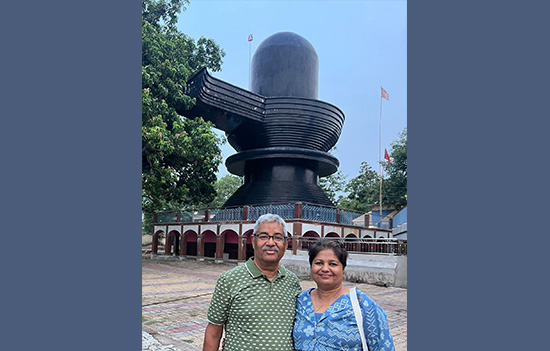 Harihar Dham.
Harihar Dham.
We slept early as we had planned to
climb the Sammed Shikhar Ji on fourth day.
Day 4 Sammed Shikhar Ji
We started preparing ourselves mentally for
covering a distance of 27 kilometres to Shikharji, 9 kilometres uphill climb, 9
kilometres to visit the temples at the top and 9 kilometres of downward
journey.
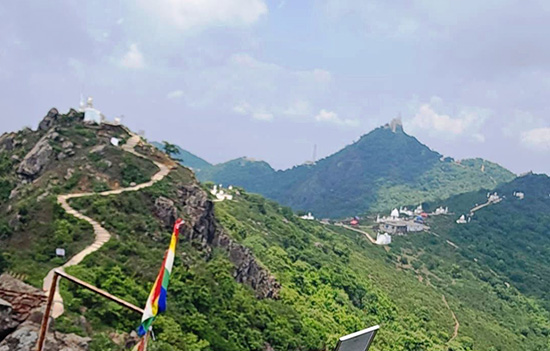 Top of Sammed Shikharji. Hilltop spread over 9 kms.
Top of Sammed Shikharji. Hilltop spread over 9 kms.
The journey can be done by Doli or Motorcycle, but we decided to go
on foot.
We started the trek to Sammed Shikhar Ji
at 2:40 in the morning and completed the 27 km trek in 16 hours. We were
extremely happy with our achievement when we reached down at 6:40 in the
evening.
During these 16 hours we walked, rested
and consumed beverages (water, lemonade, sugarcane juice) only and had no solid
food.
20 out of 24 Jain Tirthankaras attained
Nirvana at Sammed Shikhar Ji.
We visited the Nirvana Sthal of each
Tirthankara on different hills and paid our respects. At all these places there are no murtis of
any Tirthankar, only foot prints are engraved in marble, which are called
Pagaliya Ji in Jaina darsana.
There is only one temple at the top of
the hill named Jal Mandir which has a murti of Jain Tirthankar. At this temple, the pilgrim has to take a
bath, wear new clothes and then only is allowed to offer prayers to the deity.
It would not be out of place here to
know the places of nirvana of the remaining 4 tirthankaras i.e. Rishabh Dev at Ashtapad,
Vasupujya at Champapuri, Arishtanemi at Girnar and Mahaveer Swami, Pavapuri.
When we reached Dharamshala Siddhayatan,
we were more tired than hungry. Luckily
we had requested to arrange for masseurs before leaving for the hill. The masseurs were ready with all their magic
oils and lotions. After a proper massage for 45 minutes we were relieved of some
pain. We paid Rs. 300/- for the service to each of the masseurs.
We had a light dinner and went off to
sleep as our morning train to Gaya was at 4.30 am.
Day 5 Gaya, Bodh Gaya and Rajgir
We took a train from Parasnath station
to Gaya and reached Gaya at 6.45 am.
Gaya is a major place for performing the
ritual of Pind Daan among Hindus. This city is situated on the banks of
the Falgu River and the ritual of Pind Daan is performed from the
Vishnupad Temple built on the river bank.
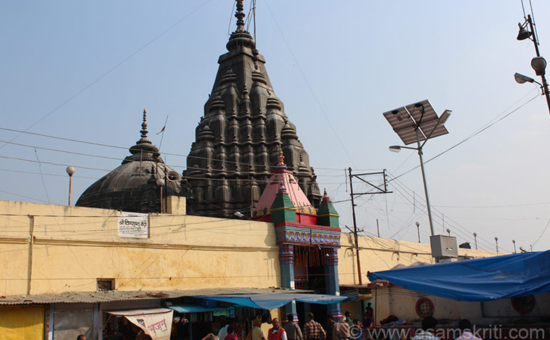 Vishnupad Mandir built by Ahilyabai Holkar.
Vishnupad Mandir built by Ahilyabai Holkar.
Sita Mata had cursed the Falgu river
that it will never have water on the surface but water will come out by digging
2-3 feet. The story goes that Lord Ram,
his brothers and Sita Mata had come to Gaya to offer Pind Daan of their
father King Dashrath. Brothers went to the river for a bath and in their
absence Mata Sita had to do the Pind Daan of King Dashrath due to some
emergency. When Lord Ram returned with
his brothers, he asked Mata Sita about the Pind Daan, which she said she was
done and as witness she called River Phalgu, Akshay Tree, a Cow, Tulsi Plant
and a Brahman. But the River, Cow, Tulsi, and Brahman said that no Pind Daan
was done, expecting bigger boon from Lord Ram.
Only Akshay Tree told the truth.
Angry to the core, Mata Sita condemned the River Phalgu to run below the earth’s surface to hide her head in shame for lying. Similar curses were given to Cow, Tulsi and Brahman also.
The second major temple at Gaya is of Mangala Gauri. Here we had to stand in a serpentine queue
for Darshan due to heavy rush of devotees. This is also a Shakti Peeth, one
breast of Mata Sati had fallen here. Hence, this Peeth is a symbol of
nourishment.
After Gaya, we went to Bodh Gaya i.e. about 15 kms away. Lord Buddha attained enlightenment here under a Bodhi tree. Emperor Ashok built a magnificent temple after 300 years of Lord's Nirvana. Four major locations of Buddhist of the world are shown in pic.
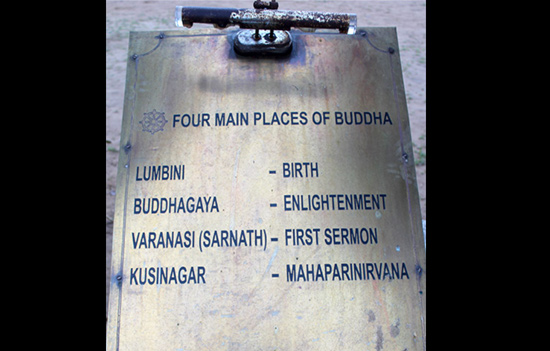
Bodh Gaya is a very sacred place for
Buddhists. Buddhists from many countries have built very beautiful temples
here. The temple built by Japan has a very beautiful statue of Lord Buddha made
of stone. It is 80 feet high.
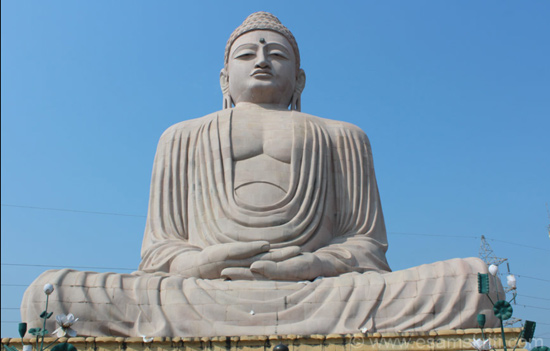
From Gaya we left for Rajgir by taxi at two o'clock in the afternoon. During the conversation, the driver asked, would we like to see the workplace of Dashrath Manjhi? On our agreeing, he took us to Manjhi's village 'Gehlor', 5 kms from the main road.
Single-handedly, with the help of a
hammer and a chisel, Dasharatha cut through the mountain and built a road to
reduce the distance to his village by half.
We travelled on the road built by Manjhi.
After reaching Rajgir in the evening, we
ate dinner and slept in a Jain Dharamshala.
Day 6 Rajgir
RAJGIR
is important for Buddhists, Jains and Sanatanis.
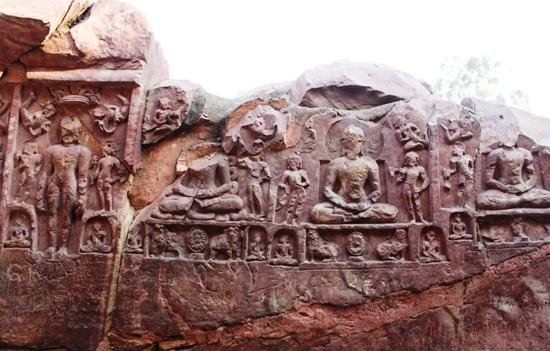 Jain Sculptures outside Sonbhadra Cave.
Jain Sculptures outside Sonbhadra Cave.
To read a detailed travelogue on Rajgir
At a distance of 18 km from Rajgir, are
the ruins of the ancient University of Nalanda.

It is said that there were 108 hostels and
each hostel had proper arrangements for living, bathing, kitchen, water
storage, meditation. 10,000 students, 1000 teachers and 1000 other employees lived
in Nalanda University Campus. Subjects
like Mathematics, Medicine, Astronomy, Physics, Chemistry, Political Science,
Languages and Art and Crafts were taught at the University.
In the 12th century, Bakhtiyar Khilji
burnt down this entire university. It is said that there were so many books in
the library that it kept burning for six months.
From Nalanda we went to Kundalpur,
according to the Digambara sect of Jainism, Mahavir Swami was born here.
The next stop was Pavapuri. Mahavir
Swami attained Nirvana here.
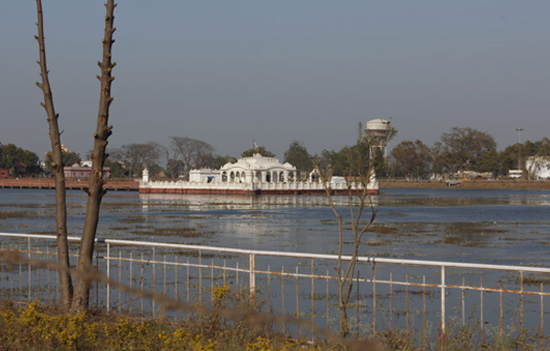
Day 7 Patna
On 7th Day of our journey we caught
the 5 am passenger train for Patna.
For the first time we saw train stopping
at places where there were no stations, people boarding and alighting at such
stops. These halts are pre-determined. We asked some people, how people boarding
like this get tickets? But we did not get any proper answer meaning travel was ticketless.
We reached Patna at around 9 am and
checked into a Jain Dharamshala.
In Patna, we first went to pay our obeisance
at Gurudwara Harimandir Sahib. This is the place where the tenth Guru, Govind
Singh ji was born.
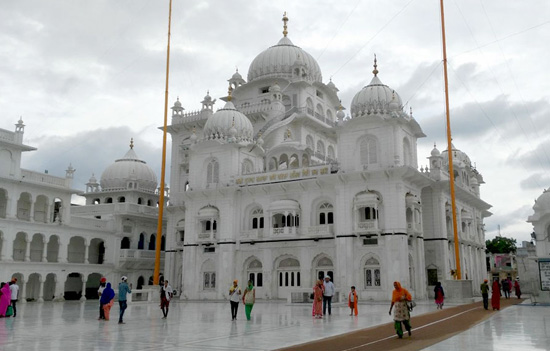
This is one of the 5 major Gurdwaras (Takht) of the Sikh tradition. The five major Takhts being Akal Takht, Hari Mandir Amritsar, Patna Sahib, Patna (Guruji's birth place), Anandpur Sahib, Punjab (Guruji founded the Khalsa Sect there on 30/3/1699), Damdama Sahib, Bathinda, Punjab and Nanded Sahib, Nanded, Maharashtra.
With a visit to Patna Sahib Gurudwara we
completed our wish of visiting all five holy places of Sikh tradition was fulfilled.
Another sightseeing and historical place
in Patna is Gol Ghar.
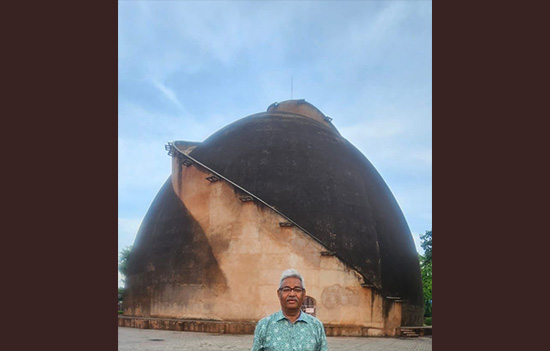 At Gol Ghar.
At Gol Ghar.
Before 1784, there was a terrible famine
in the eastern part of India; millions died of hunger. Then, the then British
government decided to build a very big food grain warehouse. Thus, construction
of the warehouse started in 1784 under the supervision of Captain John Garston.
It was completed in 1786.This circular warehouse built in the middle of the
city is 29 meters high, has a diameter at the ground level of 125 meters. 6.40
lakh tonnes of food grains could be stored in this warehouse.
To climb it, two stairs were made, one
for climbing with the grain and the other for descending after pouring the
grain.
In the evening we went to Ganga Ghat for
boating and saw the view of the city from the other end of Ganga.

Day 8 Patna
This was the last day of our tour and
before catching flight to Mumbai at 2 pm we visited two famous holy places,
Gurudwara Kangan Ghat and Gurudwara Bal Leela. Both these places are near to
the Patna Sahib Gurudwara.
Gurudwara Bal Leela is the place which Guru
Govind Singh visited in his child hood.
The local queen of that time would serve him delicious breakfast,
suitable for a child and in remembrance of that, even today the morning Langar
at this Gurudwara is very delicious and enjoyed by all devotees.
We returned to Mumbai taking a 2 pm
flight.
Author is a Mumbai based Chartered Accountant who post retirement travel across Bharat and shares experiences.
Also
see albums of
1. Bodh Gaya One and Two has Monasteries built by various countries
2. Great Buddha Statue
3. Nalanda
4. New Nalanda University, Rajgir
5. Hiuen Tsang Memorial, Nalanda
6. Rajgir
7. Pawapuri
8. Baidyanath Jyotirling